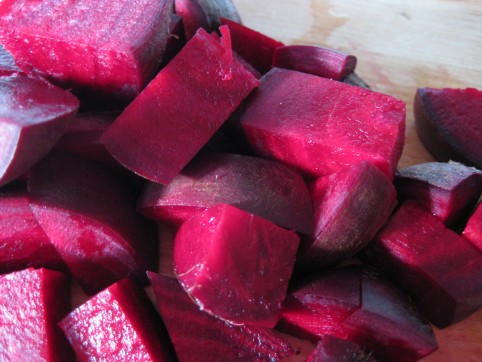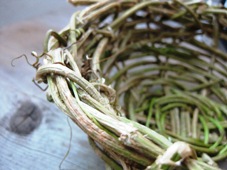
Beet kvass is a favorite at our house! It’s so easy to make and so good for your body, and we love the taste — salty, sour, very refreshing.
Beets are extremely nutrient rich and have long been valued as a blood tonic (and their doctrine of signatures would suggest this — they make everything look bloody after you’ve cut into them!). They are rich in iron, calcium, magnesium, phosphorus, carotene, B complex, copper, and vitamin C. Beets and their greens contain special substances that protect the liver and stimulate the flow of bile (Nourishing Traditions, p. 373). And drinking beet kvass is especially beneficial to digestion because it’s lacto-fermented and therefore contains beneficial enzymes and bacteria for your digestive tract. It’s an all-around health tonic, and according to p. 610 of Nourishing Traditions, beet kvass promotes regular elimination, aids digestion, alkalinizes the blood, cleanses the liver, and is a good treatment for kidney stones and other ailments.
Well, all I know is that it tastes good!
The recipe in Nourishing Traditions describes letting your beet kvass ferment for 2 days on the counter and then refrigerating it. However, I find it usually needs to ferment a lot longer than that. I let mine go a week or two on the counter, until the kvass is completely opaque — a deep, thick red that you can’t see through. I give it a taste, and if it’s sour with no hint of sweetness left, I know it’s done (though some may like to have that hint of sweetness). As with all fermentations, let it go until it tastes good to you, regardless of what the directions say.
Here’s my recipe:
Beet Kvass
8 – 10 ounces organic beets, scrubbed & coarsely chopped (I don’t bother to peel them)
1/4 cup whey* (optional)
1 Tbsp sea salt (I like unrefined sea salt because the minerals haven’t been taken out)
water
Place the salt into a 2-quart glass jar. Pour in a little warm water to dissolve the salt, and then add the beets and whey (if using). Fill the jar to the top with water. Stir and cover. Let sit at room temperature until the kvass tastes good to you — several days to a couple weeks, depending on your kitchen temperature and your tastes. Transfer to the fridge. If the kvass isn’t delicious, it may need a few weeks to “do its thing” in the fridge. I always find that my ferments taste even better when they’ve been shoved to the back of the fridge for a few weeks (or…er…months!).
And I have found that the whey is an optional ingredient, even though it isn’t listed as such in Nourishing Traditions. Feel free to leave it out; your kvass will take a little longer to ferment, but will be just as delicious!
When the liquid is nearly gone from your jar, you can fill it halfway again with water (no extra salt) and let it re-ferment if you want. Or you can save some kvass to add to your new batch as an innoculant, or you can juice your spent beet chunks! Or all of the above.

Starting a new batch of beet kvass

Beet kvass, finished and ready to drink
*****
*Whey: a clear yellowish liquid that can be drained off a fermented milk product like yogurt, buttermilk, or kefir. Whey will actually last for a couple months in your fridge. There are several ways to collect it:
– Easiest way: make kefir and let it over-ferment until curds and whey have separated. Spoon off the curds, and strain the whey through a fine mesh seive.
– Another way: Place a colander or seive over a bowl. Line the colander with a clean, damp tea towel, and pour yogurt into that. Leave for a day or two in your fridge to drain. You’ll then be left with whey in the bowl and “Greek yogurt” (or “yogurt cheese” if it’s really thick) in the colander. Both are great for making dips.
*****
Troubleshooting:
My ferments, including my kvass, sometimes get a white film (kahm yeast) on top during fermentation. It looks like this:

Kahm yeast is harmless, but you’ll want to try to keep it scraped off so it doesn’t affect the flavor of the kvass too much. I do find that my kvass gains a depth of flavor when it’s had this film on it, but if you let it go uncontrolled, it can make your kvass taste weird. Try to scrape as much of it off each day as you can.
*****
































davidkrupa,
I have no idea what sugarbeets taste like. It would be a good experiment; do report back if you do it. I also have never seen them for sale as a human food product – is this one of those new trendy things?! Alcohol would need anaerobic fermentation so worst thing you’d probably get is something like vinegar, if you were to brew it as beet kvass (the technique, I mean).
Hi, I have made kvass successfully many times in the past but my most recent attempt has failed! Instead of turning that beautiful jeweled red-purple color, by day 3 my kvass is a murky brown. I used tap water in the past, but I am in a different house now – could the pH or mineral content of this different well water be my problem? Also, my mother-in-law keeps an active sourdough starter – is there a chance that my kvass batch got contaminated with the wild yeasts? If so how could I prevent this problem in future….. I am CRAVING beet kvass and am so disappointed in the current batch! Thanks in advance
Hi Lindsey,
Thank you for this great conversation! I’ve learned a lot. I have two batches of kvass going, one made with a mix of red and variegated beets, the other just red beets. They are both bland tasting after two days sitting outside before I stuck ’em in the fridge. The kvass that I buy from my CSA has a much deeper flavor.
I’m going to try bringing them back out to ferment some more. But if you have any other ideas for bland kvass, I’m all ears!
Warm regards,
Laura Pallandre
Laura,
I would leave the kvass out to ferment for much longer. Make sure you’ve added enough salt to preserve the whole thing while it ferments at room temperature. But yeah, I think the key is going to be letting it sit out to ferment longer. However if it’s not feasible to ferment at room temp, I’ve had success putting things to the back of my fridge for *months* and letting the fermentation take place at a very slow rate… and they have come out great.
Good luck!!!
Carolyn, how disappointing! I really don’t know what the cause would have been. Both things you suggested sound like a possibility, so – you’ll have to just experiment I’m afraid. Good luck getting good kvass results again — I know what you mean about craving this stuff!!!!!!!!!!!
Hi Caroline,
I occasionally end up with brown beetroot kvass also but while it doesn’t look awesome, it tastes fine. I think the time left to ferment may have something to do with it.
Wendy I’ve experienced the same thing… can’t remember what I concluded if anything, but I bet you are right with the length of time to ferment. Thanks for chiming in! In case anyone else runs into this issue…
If one would use frozen beets, would you blanch them or just cut them up so they are ready to make the kvass and freeze them.? They are organic, and of course I would wash them. We don’t always have fresh beets available.
Thank you,
Good question Nancy, I’ve never tried using frozen. I wouldn’t blanch — I’d just cut up raw and freeze. Not sure how it’ll turn out – worth a try!!
kristenk » You do not have to use an airlock. The airlock helps with fermentation, but it is not necessary! Just make sure the lid is tightly closed. I didn t use an airlock to make this batch of Beet Kvass and it turned out just fine :). Some people prefer to use the airlock though.
Lindsey, What do you think of reducing the amount of salt? How much do you and your husband drink at a time of the kvass? Maybe 3 tsp isn’t so much. I wonder whether I could use salt sole…. I think I will try that. The minerals are very available in the sole. It is a pleasure to look at your garden and site. 🙂
Hi Nandarani,
I’m so sorry it took this long to reply!
You can reduce the salt, yeah, but keep a closer eye on the kvass as it ferments since it’s more prone to spoilage and surface mold or kahm yeast with less salt. If you see these things, skim them off ASAP and keep skimming daily until your kvass is done.
I don’t know what salt sole is! Must look it up…
I’m glad you enjoy looking at my garden pictures, thank you!! (I do too) 🙂